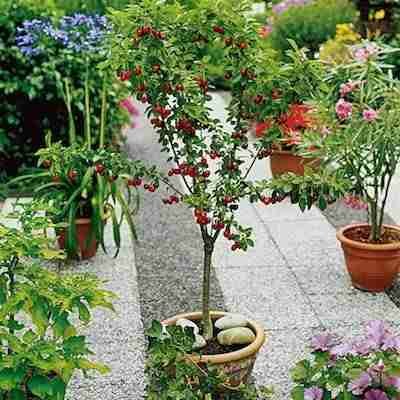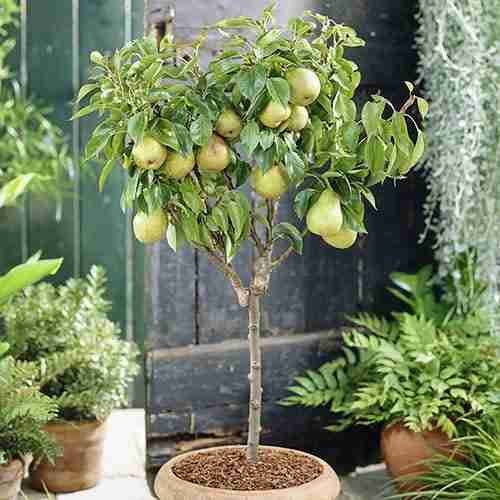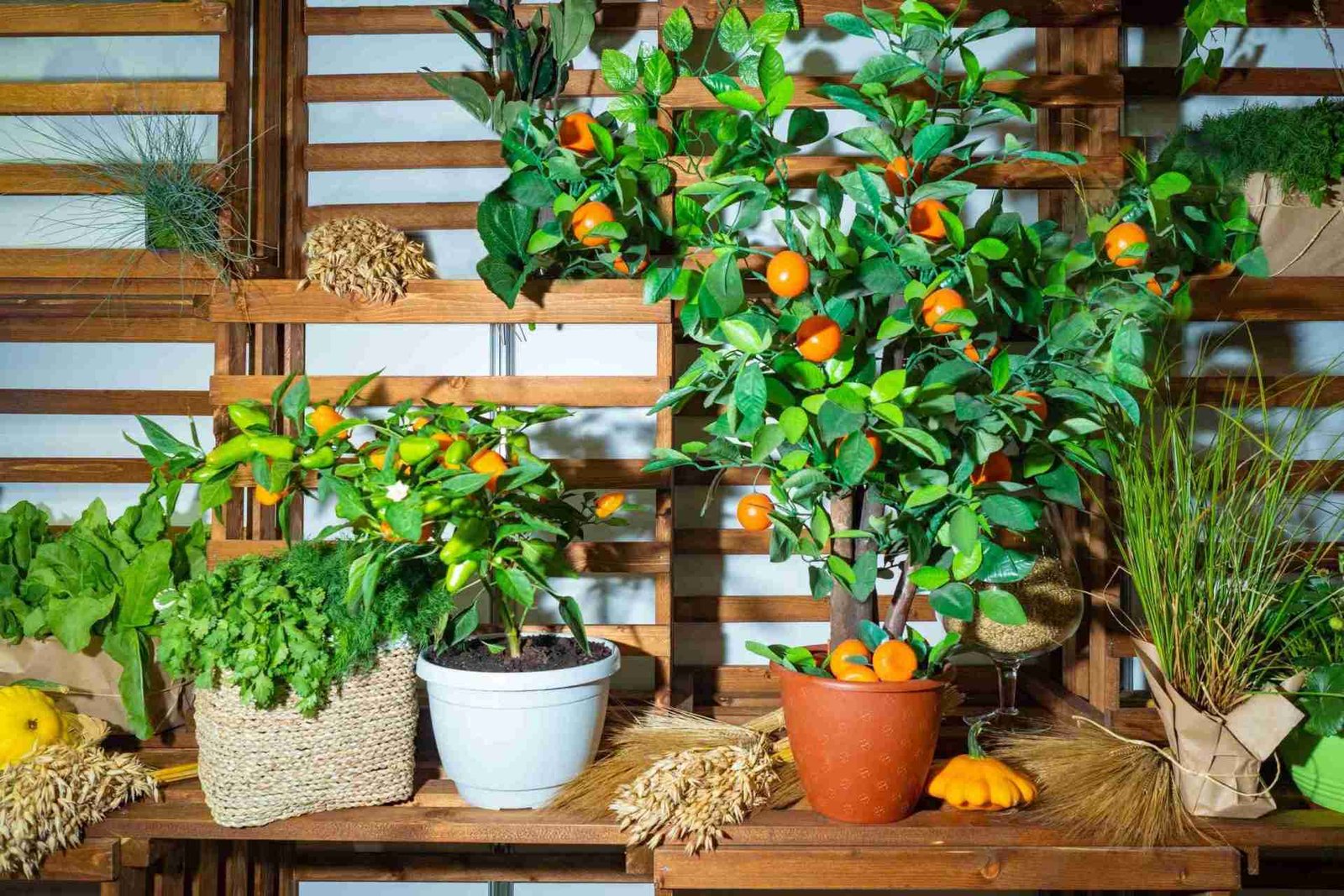I only recommend products I would use myself and all opinions expressed here are our own. This post may contain affiliate links that at no additional cost to you, I may earn a small commission.
There’s nothing sweeter than biting into a ripe, juicy fruit picked right off the tree on your patio. While many people think that fresh fruit is limited to the grocery store or the farmers market, it’s surprisingly easy to grow your own fruit trees at home, even if you have limited space. But, not all trees are suited to growing in pots on your patio in your backyard. Here’s a list of the six best fruit trees to grow in containers at home.
Why Grow Fruit Trees in Containers?
Traditionally, fruit trees are grown in orchards, where each tree has plenty of space to spread out its roots and grow. However, the quality of fruit declines as more time passes between picking and consumption. To maximize freshness, fruit trees have been bred to be smaller, dwarfed versions suitable for container gardening, making it easy to grow your own. Plus, the beautiful springtime blooms add a touch of color to your landscaping.
What Type of Container Do I Need?
Growing fruit trees at home means you need to have a large enough pot or container for the tree to thrive–the bigger your pot, the more space your tree will have to grow. You want your container to have a top diameter of at least 2 feet, be at least 1 foot deep, and ideally have a volume of 10-15 gallons. Additionally, your pot should also have drainage holes in the base for excess water to escape. When selecting your
Best Fruit Trees to Grow in Pots
When you decide to start growing your own orchard at home, you’ll want to be sure to select a fruit tree that grows well in your specific environment. Likewise, some varieties of fruit trees are more hardy than others and therefore may be easier to grow. Here are types of fruit trees that do well in pots.
Orange Trees
If you’re looking for a boost of Vitamin C and you live in a sunny climate, orange trees are an excellent option for a potted fruit tree. Unlike other fruit trees, orange trees require a minimum of 8-hours of sunlight daily. They also do best in climates with a mild winter. While standard-sized orange trees grow about 20-feet, dwarf varieties grow between 6 to 12-feet. With dwarf trees, you will often get standard-sized fruit, albeit a lower yield. They are typically self-pollinating but do have better yields with cross-pollination. Orange trees typically take 3 to 5 years to bear fruit.
If you want your tree to bear fruit sooner, consider buying a tree that’s been grafted from vigorous rootstock to grow faster and develop quicker. Suppliers such as FastGrowingTrees.com graft their trees so that they have healthful roots and well-developed branching. Unlike with trees from other nurseries or big box stores, you’ll get high-quality performance from a tree that’s designed to grow and produce faster.
You can grow nearly every variety of orange tree in a pot, but some varieties that do particularly well include Budda’s Hand, Calamondin, and Trovita. Other citrus plants, including tangerines, lemons, and limes, also do well for container gardening.
Fig Trees
Fig trees don’t often come to mind, but figs are a delicious fruit, high in minerals and vitamins, and are easy to grow in pots. In fact, figs do particularly well in places with warm summers and cool winters. Dwarf fig trees grow to 6 to 15-feet, while their standard counterparts can grow anywhere from 20 to 30-feet. Like orange trees, fig-trees will take approximately 3 to 5-years to bear fruit. Most types of figs are self-pollinating, meaning you only need one tree. Which kind of fig tree should you get? Ischia, Little Ruby Dwarf, and Violette De Bordeaux varieties all do well when planted in pots.
Cherry Trees

Cherry trees make another excellent choice for your container orchard. Whether you choose a sweet variety for eating or a tart variety for cooking, cherry trees add a touch of beauty and fragrance to your landscape. Standard varieties can be quite large, growing up to 25-feet. However, you can opt for a dwarf variety that ranges from 12 to 15-feet. You should note that not all varieties are self-pollinating. Popular self-pollinating varieties include Duke, Lapins, Morello, Nabella, North Star, and Stella varieties. The time to bear fruit will also depend on the variety you choose- standard-sized trees tend to bear fruit after 4 to 7 years, and dwarf-sized trees typically take 2 to 4 years.
Peach Trees
Even if you’re not in Georgia, peach trees do well in containers as long as you have hot summers and cold winters. Like other trees on our list, peach trees come in standard size and dwarf size. Dwarf-sized trees are recommended for pots as they only grow 6 to 10-feet instead of the standard 25-feet. While most peach trees are self-pollinating, watch for J.H. Hale and Indian Free varieties that require two trees for cross-pollination. Once you plant a peach seed, you can expect the tree to bear fruit after 3 to 4 years. If peaches aren’t your thing, you could opt for another stone fruit tree like apricot or plum.
Apple Trees
If you’re looking for a fruit tree that is easy to grow, apple trees are a good bet. While standard apple trees can grow up to 15-feet, you can also opt for a dwarfed apple tree that will grow between 8 and 10-feet. The dwarfed varieties still bear full-sized fruit but with a lower yield. Dwarf apple trees will begin bearing fruit 2 to 3 years after planting, while standard trees can take up to 8 years. You’ll also need to ensure you have two apple trees for cross-pollination. However, keep in mind that you just have to get varieties that will pollinate with each other, such as Honeycrisp, Gala, and Fuji varieties. If you don’t have space for two trees, consider getting a tree with numerous varieties grafted onto a single rootstock. To keep your trees in peak condition, you’ll want to prune them annually.
Pear Trees

Pear trees are another hardy option when growing fruit trees at home. Like apple trees, pear trees come in dwarf varieties that grow around 8 to 10-feet tall (standard varieties tend to be 18 to 20-feet tall). Dwarf pear trees have a lower yield with full-sized fruit; just make sure that you have two for cross-pollination. Some pear varieties that do well in containers include Moonglow, Bartlett, and Seckel pears. The time to bear fruit will depend on the specific variety, but dwarfed versions tend to bear fruit in 3 to 10 years. As with other trees, pruning will be crucial to keep the size manageable.
Choosing the Right Fruit Tree for Your Home
When deciding which type of fruit trees to grow at home, you want to make sure you understand the needs of the disfigured variety you choose. Some trees, such as apples and pear, require two different trees for pollination. If you don’t want two of the same type of tree due to space constraints, consider choosing a self-pollinating variety such as peach and sour cherries, or opt for a tree where several varieties are grafted on a single rootstock. You’ll also want to consider the climate, sunlight, and soil requirements before settling on the type of fruit tree for your home. If you’re not sure where to start, your local greenhouse may be able to give some guidance. Or check out all of the resources available at FastGrowingTrees.com, the largest online tree nursery.

